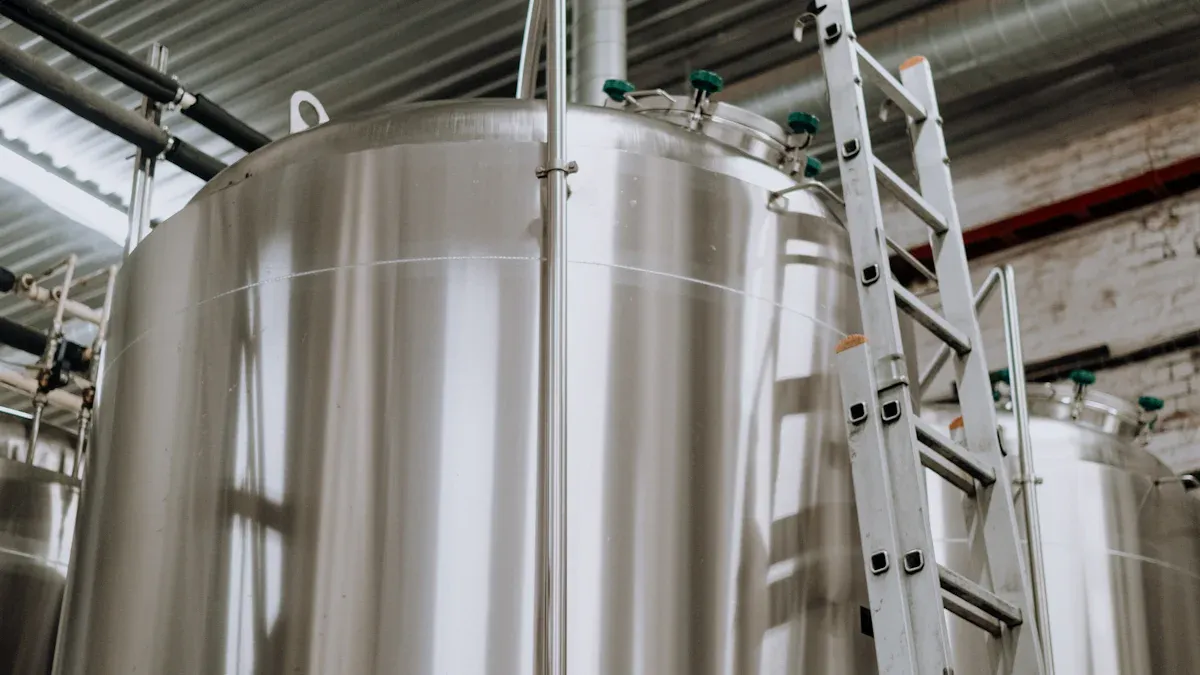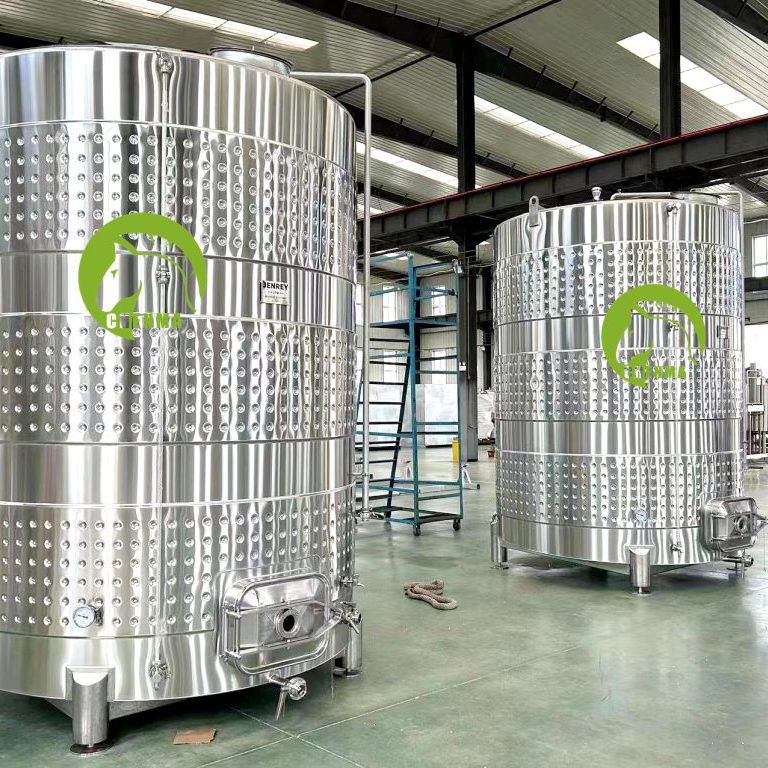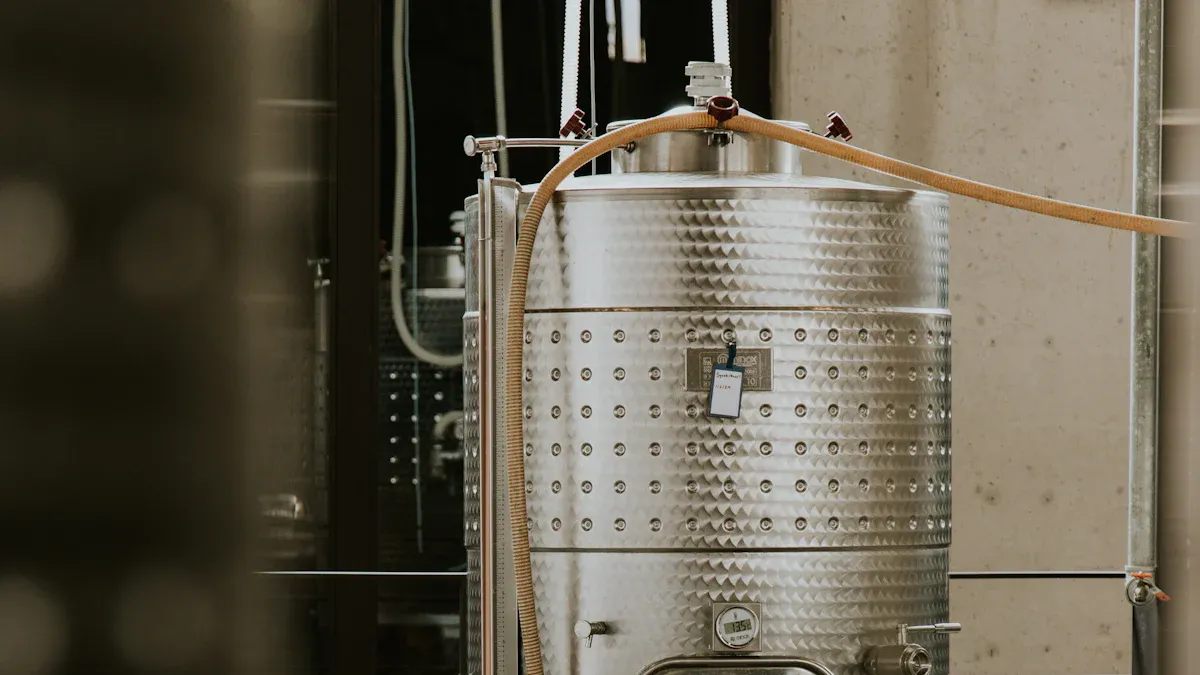
Choosing the right wine fermentation tank supplier shapes the future of your wine business. You need equipment that matches your wine production goals, supports quality, and fits your budget. Each wine fermentation tank impacts taste, consistency, and safety. Reliable support and the ability to customize tanks help you adapt as your wine business grows. Consider both your current needs and where you want your wine operation to go.
Your Needs
Production Scale
When you choose fermentation tanks, you must first consider your wine production scale. The size of your winery shapes the type of wine making equipment you need.
- Large commercial wineries often select stainless steel tanks. These tanks offer durability, easy cleaning, and precise temperature control. They help you produce consistent, high-volume wine with lower maintenance costs.
- If you run a boutique or craft winery, you may prefer variable volume tanks. These tanks give you flexibility for different batch sizes. You can also explore concrete or ceramic tanks if you want to create unique wine styles or highlight specific terroirs.
- Oak tanks work well for wineries that focus on high-quality, personalized wines. They allow for long-term aging and complex flavor development.
- Your choice of tank material—stainless steel, oak, cement, or ceramic—depends on your production volume, desired wine style, and budget.
- Reliable suppliers offer global technical support, spare parts, and expert installation. These services become more important as your production scale grows.
You should also think about environmental impact. Many winemakers now look for tanks and suppliers that reduce resource use and emissions during the fermentation process.
Tank Features
The features you need in your wine fermentation tanks depend on your wine style and operational goals. Commercial wineries often request tanks with specific features:
- Open tanks work best for red wines, allowing heat to escape and skins to mix with juice during fermentation.
- Closed tanks suit white and rosé wines, protecting them from oxidation.
- Stainless steel construction remains popular for its durability and ease of cleaning.
- Floating lids with inflatable membranes let you adjust the tank’s capacity and create airtight seals. This protects your wine from oxygen.
- Fermentation locks allow CO2 to escape but keep air out, which helps maintain wine quality.
- Spigots and valves make racking, filtering, and bottling easier.
- Man doors and sight glasses help you clean and monitor the wine fermentation process.
- Some wineries use inert gases like nitrogen or argon in the headspace to prevent oxidation.
- Customizable tank sizes, shapes, and fittings help you match your wine production needs.
Tip: Choose features that make the fermentation process easier, improve cleaning, and protect wine quality. Customization from your supplier can help you achieve the best results.
Wine Fermentation Tank Options
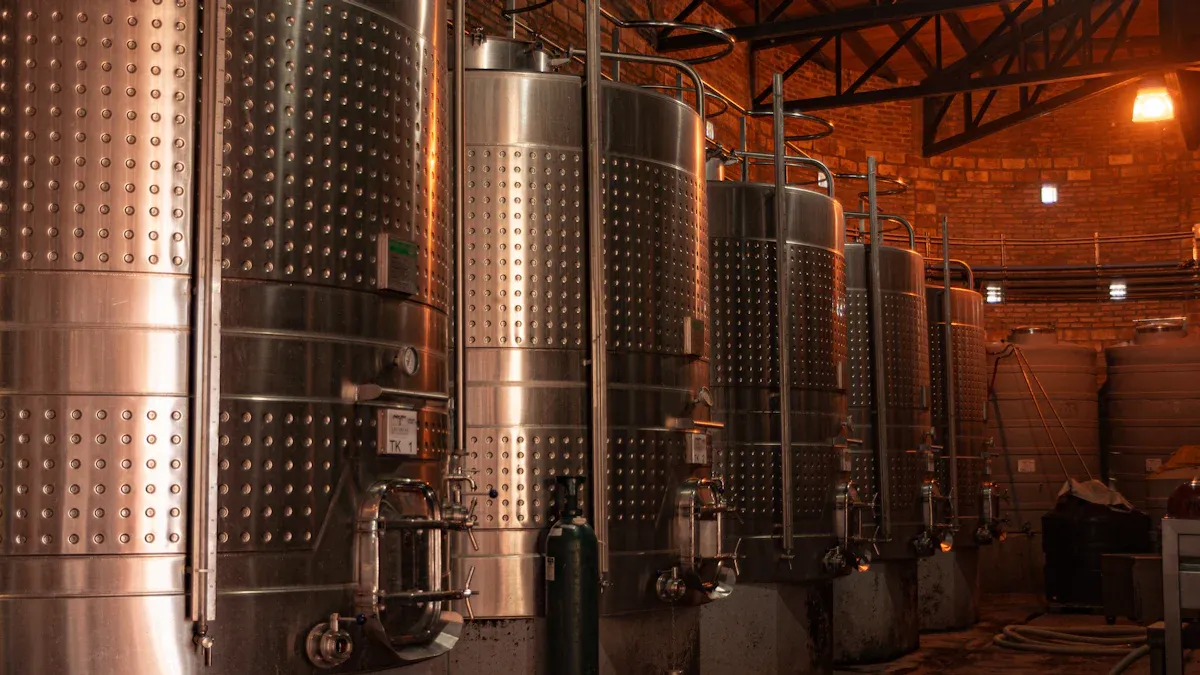
When you choose wine tanks, you have several options. The right material and design will help you control the wine fermentation process and reach your winemaking goals. Each type of tank offers unique benefits for the fermentation process, wine quality, and daily operations.
Stainless Steel
Stainless steel wine tanks are the most popular choice for modern wineries. You see them in both large commercial cellars and small boutique operations. These tanks offer many advantages:
- Exceptional durability and corrosion resistance. Stainless steel stands up to acidic grape juice and lasts for many years.
- Easy cleaning and maintenance. The smooth, non-porous surface prevents bacteria from growing and makes sanitation simple.
- Precise temperature control. Stainless steel tanks often include cooling jackets or a glycol cooling system. You can manage the fermentation temperature closely, which is important for delicate wines.
- No flavor or odor impact. Stainless steel does not add any taste to your wine, so you keep the pure grape character.
- High structural strength and pressure resistance. These tanks work well for sparkling wines and large-scale production.
You may notice that stainless steel tanks have a higher initial cost than concrete or plastic tanks. However, their long service life and low maintenance often make them a smart investment. Stainless steel tanks do not allow oxygen exchange, so they preserve freshness and natural flavors, especially in white wines.
You can choose from many types of stainless steel wine tanks:
- Variable volume tanks with floating lids for flexible batch sizes.
- Conical fermentation tanks for easy sediment removal.
- Sealed tanks for controlled wine fermentation.
- Open fermentation tanks for red wine production.
- Insulated wine storage tanks for stable temperatures.
Chenma offers a wide range of stainless steel wine fermentation tank options. You can customize the size, shape, insulation, cooling jackets, and glycol cooling system. Chenma’s engineering team can design tanks to fit your space and production needs. Other suppliers, such as Marchisio and ALBRIGI, also provide stainless steel tanks with features like modular design, integrated cooling jackets, and adjustable lids. These options help you match your wine tanks to your winemaking style.
Note: Most wineries use semi-automatic fermenters. These tanks combine manual and automatic controls, giving you flexibility and control during the wine fermentation process. Semi-automatic tanks hold about 85% of the market share, while automatic fermenters are growing in popularity due to new technology.
Concrete & Other Materials
Concrete wine tanks have become popular for winemakers who want to add complexity and texture to their wines. Concrete tanks, such as the handcrafted egg-shaped tanks by Oeuf de Beaune, offer natural insulation and gradual temperature regulation. This helps you maintain a steady fermentation temperature without large fluctuations.
Here is a comparison of concrete and stainless steel wine tanks:
| Aspect | Concrete Tanks | Stainless Steel Tanks |
|---|---|---|
| Cost | Lower initial cost, but may need repairs for cracks | Higher initial cost, especially for large tanks and advanced features |
| Durability | Durable but porous; needs maintenance to prevent contamination and cracking | Highly durable, corrosion-resistant, long lifespan, low maintenance |
| Wine Quality Impact | Allows gentle oxygen exchange, enhancing texture and minerality | No oxygen exchange; preserves natural grape characteristics |
| Maintenance | Requires careful cleaning and monitoring for cracks | Easier to clean, less prone to contamination, low maintenance |
| Installation | Heavy and labor-intensive | Easier to install and handle |
Concrete tanks allow a small amount of oxygen to reach the wine. This gentle oxygen exchange can improve texture and minerality without adding flavors. However, concrete tanks need regular cleaning and inspection for cracks. Their weight makes installation more difficult.
Other materials, such as oak and ceramic, also play a role in winemaking. Oak tanks add flavors like vanilla and spice, which can enhance certain wine styles. Ceramic tanks offer a neutral environment, similar to stainless steel, but with different thermal properties.
You can also find tanks with advanced features, such as cooling jackets and glycol cooling systems, in both stainless steel and concrete designs. These systems help you control the fermentation temperature and protect wine quality.
Chenma stands out for its ability to customize wine tanks for your specific needs. You can request tanks with special insulation, cooling jackets, glycol cooling systems, or automated monitoring. Chenma’s turnkey solutions include process design, equipment installation, and technical training. Other suppliers, like Marchisio and ALBRIGI, also offer a variety of tank materials and customization options, such as modular designs and integrated cooling systems.
Tip: When you select wine tanks, think about your wine style, production scale, and the features you need for the fermentation process. Customization helps you get the best results for your winery.
Supplier Research
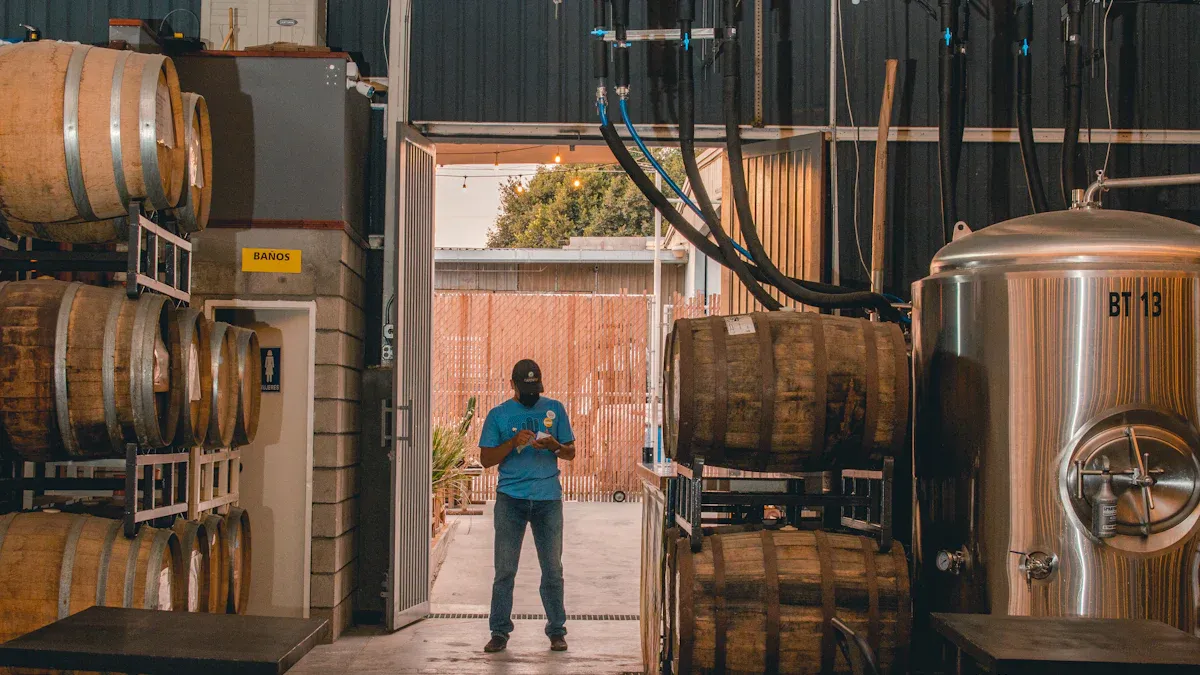
Where to Search
You can find reliable wine fermentation tank suppliers in several places. Start by visiting trade shows and wine industry expos. These events let you see tanks up close and talk to company representatives. Many suppliers also list their products on online marketplaces that focus on winery equipment. You can use industry directories to compare suppliers and read reviews from other winemakers.
Professional wine associations often share supplier recommendations. You can join online forums or social media groups for winemakers. Members often share their experiences with different suppliers. Local winemaking schools and consultants may also suggest trusted companies. When you search, look for suppliers who have experience with your type of wine and production scale.
Shortlisting
After you gather a list of potential suppliers, you need to narrow it down. Experts recommend several criteria to help you choose the best partner for your wine business:
- Match tank size to your current batch size and future production goals.
- Prioritize essential tank features, such as temperature control, cleaning system design, and material grade.
- Check that suppliers provide certifications like ASME and AS1210. These show the tanks meet safety and quality standards.
- Compare product features, warranties, and transparent pricing among your shortlisted suppliers.
- Evaluate service quality. Look for fast response times, custom solutions, and a willingness to build a long-term partnership.
- Request detailed quotes. Make sure they cover all costs, including shipping, installation, and accessories.
- Consider supplier expertise and after-sales support. Good support helps with smooth installation and ongoing maintenance.
- Focus on tanks that offer durability, corrosion resistance, and energy efficiency. These qualities support a long-term investment in your wine operation.
Tip: Take your time during the shortlisting process. The right wine fermentation tank supplier will help your wine business grow and succeed.
Wine Tanks: Quality & Certifications
Industry Standards
When you select wine tanks for your winery, you need to look at industry standards that ensure product quality and safety. These standards guide how manufacturers design, build, and test tanks for wine fermentation. You want tanks that help you control every step of the fermentation process. This control leads to better wine and a safer work environment.
Modern wine tanks use advanced features to support controlled fermentation. Temperature-controlled fermenters let you set and maintain the perfect temperature for yeast activity. This helps you create uniform and predictable wine. pH monitoring systems allow you to check acidity levels and make adjustments as needed. By managing oxygen and preventing oxidation, you protect the aroma and taste of your wine.
Many high-quality wine tanks include:
- Stainless steel construction with conical bottoms for easy removal of yeast and sediment.
- Dual-zone cooling jackets for precise temperature control, which keeps yeast active and preserves aroma.
- Closed fermentation structures that prevent oxidation and keep your wine safe from contamination.
- Airlock and breather valves that let CO₂ escape while blocking outside air.
- Agitation and recirculation systems to mix yeast and sugar evenly.
- Sampling valves for real-time checks on sugar, acidity, and alcohol levels.
- CIP (Clean-In-Place) systems that automate cleaning and keep tanks hygienic.
- Safety valves and pressure gauges to monitor and control pressure during fermentation.
- Intelligent control panels for real-time monitoring and automatic adjustments.
These features work together to give you precise control over fermentation. You get consistent, high-quality wine with every batch. You also reduce the risk of contamination and improve safety in your winery.
Tip: Always ask your supplier about the specific features and standards their wine tanks meet. This helps you choose equipment that supports your winemaking goals.
Certifications
Certifications show that wine tanks meet strict international and regional standards. When you buy certified tanks, you know they have passed tests for quality, safety, and compliance. Leading suppliers display their certifications to give you confidence in their products.
Here is a table of common certifications and what they mean for you:
| Certification | Significance |
|---|---|
| ISO9001 | Quality management system ensuring consistent product quality |
| ISO22000 | Food safety management system ensuring safety in food-related products |
| ISO45001 | Occupational health and safety management ensuring workplace safety |
| CE | European conformity marking for product safety and compliance |
| PED | Pressure Equipment Directive ensuring safety of pressure vessels |
| API650 | Industry standard for welded tanks for oil storage, ensuring structural integrity |
| AS1210 | Australian standard for pressure vessels ensuring safety and quality |
| AS1692 | Australian standard for stainless steel tanks ensuring durability and compliance |
| CSA | Canadian Standards Association certification for safety and quality |
You should look for wine tanks with certifications that match your region and production needs. These certifications prove that the tanks are safe, reliable, and ready for export if you plan to sell your wine internationally.
Chenma holds important certifications such as ISO9001 for quality management and CE certification for European safety standards. These certifications show Chenma’s commitment to safety, quality, and environmental responsibility. When you choose Chenma, you get wine tanks that meet strict industry requirements. Other top suppliers also hold similar certifications, but always check the supplier’s portfolio to make sure their tanks meet your specific needs.
Note: Certified wine tanks help you meet legal requirements and industry best practices. They also make it easier to pass inspections and audits.
Customization
Standard vs. Custom
When you choose wine tanks, you face a key decision: standard or custom. Standard tanks work well for many wineries. They use SUS304 stainless steel, which is cost-effective and provides good corrosion resistance. These tanks offer basic cooling jackets and simple cleaning systems. You can use them for general wine fermentation needs.
Custom wine tanks give you more control and better performance. They often use SUS316L stainless steel, which resists corrosion even in high-acid wines. Custom tanks can include advanced features like dual-zone dimple jackets for precise temperature control, automated cleaning-in-place (CIP) systems, and special agitators. These upgrades help you improve temperature stability, sanitation, and wine quality. Custom tanks cost more, but they last longer and adapt to your unique process.
Here is a quick comparison:
| Aspect | Standard Tanks | Custom Tanks |
|---|---|---|
| Material | SUS304 stainless steel | SUS316L stainless steel |
| Cooling System | Basic cooling jackets | Dual-zone dimple jackets |
| Cleaning | Manual or basic cleaning | Automated CIP systems |
| Features | Standard cone-bottom, basic valves | Agitators, modular extensions, certifications |
| Cost | Lower | Higher |
| Performance | General use | Enhanced control and adaptability |
| Lifespan | Standard engineering | Precision welding, longer lifespan |
Tip: Custom wine tanks help you reach higher quality and efficiency, especially if you have special wine styles or large production goals.
Turnkey Solutions
Turnkey solutions make your wine project easier. You get everything from design to installation and training. Chenma stands out for its strong engineering team and custom manufacturing. The team works with you from the first idea to the final setup. They use 3D modeling and advanced software to design tanks that fit your space and process. Chenma also offers process design, equipment manufacturing, installation, and technical training as part of their turnkey projects.
Other suppliers, such as Spokane Stainless Technologies and Micet Group, also provide turnkey solutions. They help with facility layout, process design, and full system integration. These companies supply not only wine tanks but also refrigeration, piping, and control systems. You can start your wine business with confidence, knowing experts support you at every step.
When you choose a supplier with turnkey services, you save time and avoid mistakes. You get wine tanks and systems that work together for smooth, efficient wine production.
Pricing & Value
Requesting Quotes
When you reach out to suppliers for wine fermentation tanks, you want to get accurate quotes. Clear information helps suppliers understand your needs and provide the best options. Start by listing the type of wine you plan to make. Different wines need different tanks. For example, white wine often uses stainless steel tanks to keep flavors fresh. Red wine may use oak or ceramic tanks for added character.
You should also include these details in your quote request:
- Tank type: open-top, closed-top, variable capacity, jacketed, or conical.
- Material: stainless steel, ceramic, plastic, or oak.
- Capacity: the size you need for your wine batches.
- Features: airtight seals, easy cleaning, temperature control, and any custom options.
- Fermentation style: such as open-top for manual punch-downs.
Tip: The more details you provide, the easier it is for suppliers to match your wine production needs.
Here is a table showing typical price ranges for wine fermentation tanks by material and capacity:
| Capacity | Material | Typical Price Range (USD) |
|---|---|---|
| 5 Gallons | Glass | $50 – $100 |
| 5 Gallons | Stainless Steel | $150 – $300 |
| 50 Gallons | Plastic | $300 – $500 |
| 50 Gallons | Stainless Steel | $1,000 – $2,500 |
| 500 Gallons | Stainless Steel | $5,000 – $10,000 |
| 1,000+ Gallons | Stainless Steel | $10,000 and up |
Comparing Offers
When you receive quotes from different suppliers, you need to look beyond the price. Focus on what each offer includes. Stainless steel tanks last over 20 years and make cleaning easy. Tanks with cooling jackets help you control fermentation temperature, which is important for wine quality.
Consider these factors when comparing offers:
- Capacity: Make sure the tank fits your wine production volume.
- Space: Check if the tank fits in your winery.
- Design: Look at the number of tanks, their layout, and features like conical bottoms or variable lids.
- Customization: See if you can add features such as temperature control or special fittings.
- Delivery time: Ask when you will get your tanks.
- Supplier reputation: Choose suppliers known for quality and good support.
Note: A higher price may include better materials, more features, or longer warranties. Always compare the full value, not just the cost.
After-Sales Support
Warranty
When you invest in wine fermentation tanks, you want to know your equipment is protected. Most suppliers offer warranties that cover defects in materials and workmanship. These warranties help you avoid unexpected costs if something goes wrong. You should always compare warranty terms before making a decision.
Here is a table showing typical warranty coverage for wine tanks:
| Tank Type | Warranty Period | Material | Notes |
|---|---|---|---|
| Winery Tank | 5 years | Stainless Steel | Standard warranty across suppliers |
| Fermentation Tank | 5 years | SS 304/316 | Warranty focuses on steel durability |
| Wine Tanks (Micet) | 5 years | AISI 304/316 | High-quality stainless steel, tested |
Chenma provides a 3-year warranty on wine fermentation tanks and core components. This warranty covers both the tank and important parts, giving you peace of mind. Some suppliers may offer longer periods, but you should also look at what the warranty includes. Good warranty support means you can get free replacement parts and quick help if you have a problem.
Tip: Always read the warranty details. Check what is covered, how to make a claim, and if there are any extra costs.
Technical Service
After you buy your wine tanks, you need strong technical support. Chenma stands out by offering a full range of after-sales services. You get on-site installation and assembly help from skilled engineers. The team provides technical training so you and your staff can use the equipment safely and efficiently.
You can expect these services from Chenma:
- On-site installation and setup for your wine tanks.
- Technical training for your team as part of turnkey projects.
- Follow-up support for any equipment or process questions.
- Free replacement parts during the warranty period.
- Lifelong technical support and advice from experienced engineers.
- Global after-sales service with support centers in many countries.
Other leading suppliers also offer technical support, but the level of service can vary. You should compare how quickly each company responds, what training they provide, and if they offer ongoing help. Strong after-sales support helps you keep your wine production running smoothly and reduces downtime.
Good after-sales service is just as important as the tank itself. Choose a supplier who will support you for the life of your wine equipment.
Customer Feedback
Reviews
When you choose a wine fermentation tank supplier, customer reviews give you real-world information. These reviews help you see how suppliers perform in actual winery settings. Many winemakers share their experiences with product quality, delivery, and support. You can learn a lot from their stories.
- Customers often describe suppliers as reliable partners who focus on quality.
- Many reviews mention that the tanks are durable, easy to clean, and precise.
- Winemakers praise the quick response from customer service teams. They say staff members solve urgent needs and answer questions with patience.
- Some reviews highlight the helpfulness of designers and engineers. These experts work with you to create custom solutions for your wine production.
- People also note that suppliers deliver tanks on time and keep them informed during the process.
Customer feedback shows that companies like Chenma Machinery offer hygienic, certified stainless steel tanks. Their products meet strict standards such as ISO9001 and CE. This gives you confidence in both safety and quality.
You should look for reviews that mention both the product and the service. Positive feedback about cooperation and communication means you can expect a smooth experience.
References
References from previous clients help you make a smart choice when selecting a wine fermentation tank supplier. Speaking with other winemakers gives you firsthand knowledge about the supplier’s reliability and service.
- References confirm the supplier’s reputation and experience in the wine industry.
- Positive comments from other wineries show that the supplier is trustworthy and delivers on promises.
- Real-world feedback helps you understand how the tanks perform during daily wine production.
- Contacting references lets you ask about customer support, delivery times, and any challenges faced.
- This step reduces your risk and helps you feel confident in your decision.
Tip: Always ask suppliers for references. Talking to other winemakers helps you see if the supplier meets your needs and supports your wine business.
Mistakes to Avoid
Ignoring Support
You might think that buying a wine fermentation tank is a one-time event. In reality, support from your supplier plays a big role in your success. Many wineries make the mistake of choosing a supplier who does not offer strong support before and after the sale. This can lead to problems during setup, maintenance, and repairs. If you do not get help when you need it, your wine production can slow down or even stop.
Here are some common mistakes wineries make when selecting a supplier:
- Overlooking long-term needs, such as future production scaling and advanced features. This can limit your growth and force you to replace equipment sooner than planned.
- Ignoring customization options that match tanks to your unique wine process. This can cause inefficiencies and make it hard to adapt.
- Selecting suppliers who do not provide engineering or design services. This can result in poor equipment layout and mismatched machinery.
- Failing to check the supplier’s reputation or track record. This increases the risk of unreliable equipment and poor service.
- Not ensuring compliance with industry standards. This can lead to quality issues and safety concerns.
Tip: Always choose a supplier who offers technical support, training, and a clear warranty. Good support helps you solve problems quickly and keeps your wine production running smoothly.
Focusing Only on Price
You may want to save money by picking the lowest-priced tank. However, focusing only on price can hurt your wine business in the long run. Tanks with a low price might not meet quality or safety standards. They may lack important features, such as temperature control or easy cleaning systems. This can lead to frequent repairs, higher maintenance costs, and even lost batches of wine.
Caroline Hermann MW explains that looking only at price ignores important factors like environmental impact and future costs. For example, cheaper tanks may not help you manage carbon emissions or wastewater. This can lead to higher costs later if new rules require better equipment. You might also miss out on features that help you recycle resources or save energy. These features may cost more at first, but they protect your business and the environment over time.
Note: A narrow focus on price can reduce the long-term value of your wine fermentation tank investment. Always consider quality, durability, support, and environmental impact when making your choice.
Decision Steps
Final Shortlist
You have compared features, prices, and support. Now, you need to create your final shortlist of wine fermentation tank suppliers. Start by reviewing your top choices. Look at how each supplier meets your wine production needs. Check if they offer the right tank size, material, and features for your wine style. Make sure each supplier can deliver on time and provide strong after-sales support.
Use a simple table to compare your final options:
| Supplier Name | Tank Material | Customization | Certifications | Support Level | Delivery Time |
|---|---|---|---|---|---|
| Supplier A | Stainless Steel | Yes | ISO, CE | High | 6 weeks |
| Supplier B | Concrete | Limited | CE | Medium | 8 weeks |
| Supplier C | Stainless Steel | Full | ISO, CE | High | 5 weeks |
Tip: Choose suppliers who match your wine goals and offer reliable service.
Due Diligence
Before you make your final decision, you must perform careful due diligence. This step protects your investment and ensures you get high-quality wine tanks. Follow these important steps:
1. Visit the supplier’s facility in person or through a virtual tour. Check their process, quality control, and staff skills. 2. Ask for documents like material certificates, weld records, and inspection reports. These show the tanks meet safety and quality standards. 3. Use third-party inspection agencies such as SGS or TUV for an unbiased review, especially if this is your first order or a large purchase. 4. Review sample tanks or request photos and videos of factory tests. Watch key performance tests if possible. 5. Pick suppliers who share their quality control methods and third-party audit results openly. 6. Confirm the tanks meet international standards like ISO and CE. Ask for proof before you sign any contract. 7. If you are importing wine tanks, use independent inspection services to reduce delivery risks. 8. Clearly explain your wine production needs, such as capacity and temperature control, to avoid costly changes later.
Careful due diligence helps you avoid problems and ensures your wine business starts strong.
Next Steps
Placing Orders
You have chosen your wine fermentation tank supplier and completed your research. Now, you need to place your order. Start by reviewing your final quote. Make sure it lists all the details, such as tank size, material, features, and any custom options. Double-check the payment terms and delivery schedule. If you have questions, contact your supplier before you sign the contract.
Most suppliers will ask for a deposit to start production. You may need to provide your winery’s address and any special delivery instructions. Some companies offer online order tracking. This helps you follow your tank’s progress from the factory to your winery.
Tip: Keep a copy of your order confirmation and contract. This helps you solve any issues that may come up during delivery or setup.
Delivery & Setup
After you place your order, your supplier will prepare your wine fermentation tanks for shipment. Leading suppliers, such as Prettech, usually deliver regular wine tank orders within 30 to 60 days. If you need tanks quickly, some companies can ship stock tanks right away. Ask your supplier about their delivery options and timelines.
When your tanks arrive, check them for damage before signing the delivery receipt. Most suppliers offer on-site installation support. You can expect help with setting up your tanks, connecting cooling systems, and testing for leaks. Some companies, like Prettech, provide lifetime engineering services. This includes free parts replacement during the warranty period and ongoing technical assistance. While setup times may vary, you can rely on your supplier’s team to guide you through the process.
Note: Good setup support ensures your wine tanks work safely and efficiently from day one. Always ask about installation and training services before your tanks arrive.
You can choose the right wine fermentation tank supplier by following each step in this guide. Start by understanding your wine production needs. Compare tank features, quality, and support. Check certifications and customer feedback. Use this process to make a confident decision. When you want a solution that fits your goals, reach out to suppliers like Chenma for expert help with your wine equipment.
FAQ
What certifications should I look for in a wine fermentation tank?
You should look for ISO9001 for quality, CE for European safety, and food-grade certifications. These prove the tanks meet strict standards. Chenma tanks, for example, hold ISO9001 and CE certifications, which show a commitment to safety and quality.
How do I know if a supplier offers real customization?
Ask for examples of past custom projects. Request drawings or 3D models before production. Suppliers like Chenma provide engineering support and design tanks to fit your space and process. You should see proof of their custom work.
What is the typical lead time for wine fermentation tanks?
Most suppliers deliver standard tanks in 30 to 60 days. Custom tanks may take longer, depending on design and features. Always confirm the timeline before you order. Chenma provides clear delivery schedules and updates during production.
Why is after-sales support important for wineries?
After-sales support helps you install, maintain, and repair your tanks. Good support reduces downtime and protects your investment. Chenma offers technical training, on-site setup, and lifelong support. You get help when you need it most.

